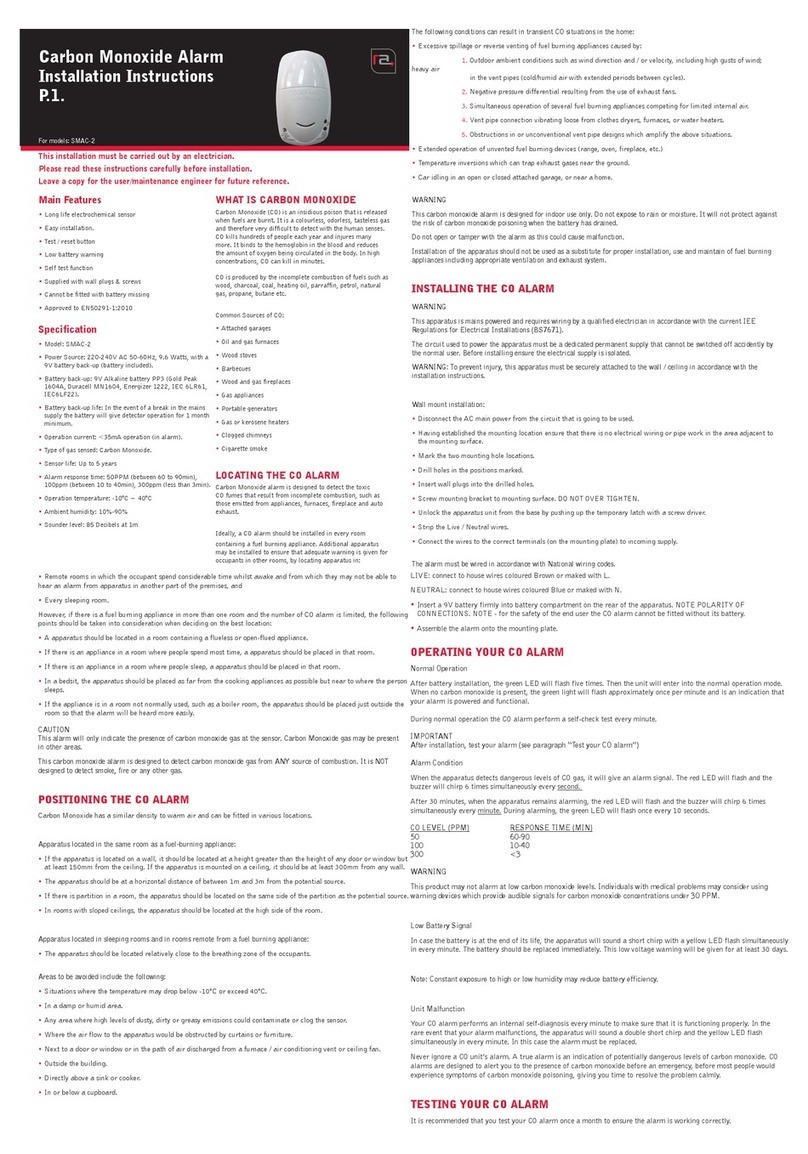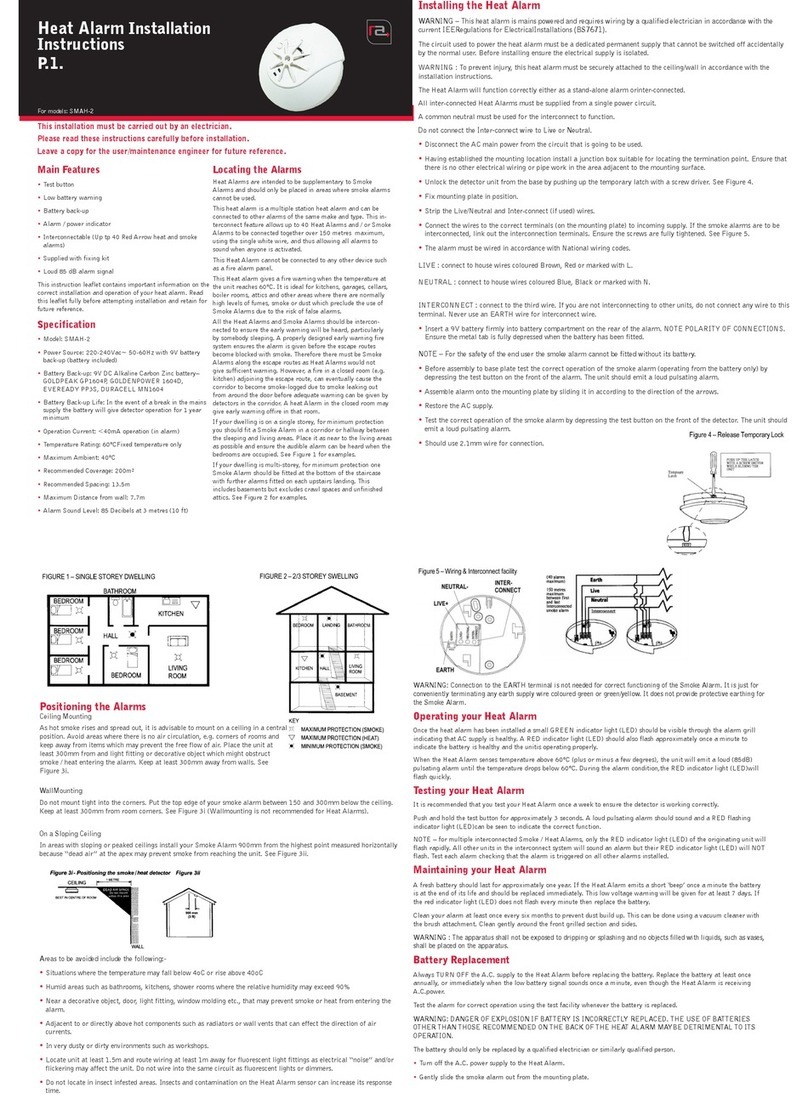
1. Fix the alarm on the wall (see diagram 1)
2. The green LED light will ash once within 50 seconds which
indicates normal operation.
3. Test the alarm by pressing the test button, at this time,
the LED will ash with“BI-BI-BI-BI”
Note: Test unit using the Test button immediately after installation.
The Test button is used to test the unit’s electronics and to hush the unit
during alarm.
Test the Unit
To test, press and release the Test button, you will hear sound
continuously and with a corresponding red LED ashing.
Note: Test the unit every month! If at any time your unit does not perform
as described, please replace it immediately.
Note: After the Test button is pressed and released, the alarm sounds and
the red alarm light ashes. This does not indicate that carbon monoxide
is present.
Hush the Alarm
If the alarm is sounding, pressing and releasing the Test button will
stop the alarm for about 10 minutes. If during 10 minutes, the CO
concentration is more than 150ppm, the alarm will sound immediately
and repeatedly.
Hush the Fault or End of Life Alert
If the FAULT or END of Life alert is sounding, pressing and releasing
the Test button will stop the alarm for about 12 hours.
1. If a dangerous level of carbon monoxide is detected, the red
alarm LED will ash continuously and the alarm will sound,
until carbon monoxide is eliminated.
2. If battery failure or low battery is detected, the battery symbol
will blank display on LCD. An intermittent “chirp”with yellow
LED ashes once every 50 seconds.
3. If sensor failure is detected, the LCD show“Err”, the yellow LED
of the alarm will ash twice approximately every 50 seconds
and the horn will synchronize two“squeak”calls.
4. When the alarm life has expired, the LCD will show“End”, the
yellow LED of the alarm will ash three times approximately every
50 seconds, the horn will synchronize three times “squeak”calls.
5. If the alarm is functioning normally, the green LED will ash
once per 50 seconds.
Warning! Action of this device indicates the presence of dangerous levels
of carbon monoxide! Carbon monoxide can be fatal!
If the alarm sounds:
1. Operate the Test button.
2. Shut down appliances and gas supply.
3. Immediately move to fresh air-outside or by an open door/
window. Do a head count to check that all persons are accounted
for. Do not re-enter the premises nor move away from the open
door/window until the emergency services responders arrive, the
premises have been aired out, and your alarm remains in its
normal condition.
4. After following steps 1-3, if your alarm reactivates within a 24
hour period, repeat steps 1-3 call a qualied appliance technician
to investigate for sources of carbon monoxide from fuel burning
equipment and appliances and inspect for proper operation of this
equipment, if problems are identied during this inspection, please
have the equipment serviced immediately. Note any combustion
equipment not inspected by the technician and consult the
manufacturer’s instructions or contact the manufacturer directly for
more information about carbon monoxide safety and this equipment.
Make sure that motor vehicles are not or have not been operating in
an attached garage or adjacent to the residence.
Operation
Test Button
LED Indicator Light
What to do if the Alarm Sounds
3. Never use detergents or other solvents to clean the unit.
4. Avoid spraying air fresheners, hair spray, or other aerosols near the alarm.
5. Do not paint the unit. Paint will seal the vents and interfere with the
sensor’s ability to detect carbon monoxide. Never attempt to
disassemble the unit or clean inside. This action will void your warranty.
6. As soon as possible, place the alarm back in its proper location
to assure continuous protection from carbon monoxide poisoning.
7. When household cleaning supplies or similar contaminants are used,
the area should be ventilated.
Warning: The following substances can aect the sensor and cause
false readings:
Methane, propane, isobutene, isopropanol, ethylene, benzene, toluene, ethyl
acetate, hydrogen sulde, sulfur dioxides, alcohol based products, paints,
thinner, solvents, adhesives ,hair sprays, after shaves, perfumes and some
cleaning agents.
Warning: Your CO alarm will not be operational and will not monitor
for CO levels without the battery.
Warning: Tampering with the alarm is dangerous.
Warning: The alarm cannot prevent the chronic eects of exposure to CO.
Warning: The alarm does not protect individuals from a specic risk.
Warning: This apparatus is designed to protect individuals from the acute
eects of carbon monoxide exposure. It will not fully safeguard individuals with
specic medical conditions. If in doubt consult a medical practitioner.
Warning: Installation of apparatus should not be used as s substitute for
installation, use and maintenance of fuel burning appliances including
appropriate ventilation and exhaust system.
To keep your alarm in a good working order, please follow
these simple steps:
1. Verify the alarm and LED lights operation by pushing the Test button
once a month.
2. Remove the unit and clean the alarm cover and vents with a soft
brush attachment once a month to remove dust and dirt.
General Maintenance
Carbon monoxide cannot be seen, smelt or tasted but can be fatal. The
build up of carbon monoxide in the blood is called the carboxyhemoglobin
level and interferes with the body’s ability to supply itself with oxygen.
Depending on the concentration of carbon monoxide, it can kill in minutes.
The most common sources of carbon monoxide are malfunctioning gas
appliance used for heating and cooking ,vehicles running in an attached
garage, blocked chimneys or ues, portable fuel burning heaters, replaces,
fuel powered tools and operating a grill in an enclosed space. Indications of
carbon monoxide poisoning include symptoms similar to the u, but with
no fever. Other symptoms include dizziness, fatigue, weakness, headache,
nausea, vomiting, sleepiness and confusion. Everyone is susceptible to
the danger of carbon monoxide, but experts agree that unborn babies,
small children, pregnant women, senior citizens and people with heart or
respiratory problems are at the highest risk for serious injury or death, each
year a qualied technician should inspect and clean your heating system,
vents, chimney, and ues.
The following symptoms are related to CARBON MONOXIDE POISONING
and should be discussed with ALL members of the household:
35 PPM: The maximum allowable concentration for continuous exposure
for healthy adults in any 8 hour period.
200 PPM: Slight headaches, fatigue, dizziness, nausea after 2-3 hours.
400 PPM: Frontal headaches within 1-2 hours, life threatening after 3 hours.
800 PPM: Dizziness, nausea and convulsions within 45 minutes.
Unconsciousness within 2 hours. Death within 3 hours.
1600 PPM: Headache, dizziness and nausea within 20 minutes. Death
within lhour.
6400 PPM: Headache, dizziness and nausea within 1-2 minutes.
The above levels of exposure relate to healthy adults. Levels dier for those
at high risk. Exposure to high levels of carbon monoxide can be fatal or
cause permanent damage and disabilities. Many cases of reported carbon
monoxide poisoning indicate that while victims are aware they are not
well, they become so disoriented they are unable to save themselves by
either exiting the building, or calling for assistance. Also, young children and
household pets may be the rst eected. Familiarization with the eects of
each level is important.
Carbon Monoxide Overview
This product is guaranteed for a period of 5 years from the date of purchase.
The guarantee is invalid in the case of improper use, tampering, removal
of the Q.C. date label, installation in an improper working environment or
installation not according to the current Regulations. Should this product
fail during the guarantee period it will be replaced free of charge, subject
to correct installation and return of the faulty unit. We do not accept
responsibility for any installation costs associated with the replacement of
this product. Your statutory rights are not aected. We reserve the right to
alter specications without prior notice.
Guarantee
INS/ELEC/0003/SHC-BAT-CA/V1
T: 0800 195 0006
sales@redarrowelectrical.co.uk
Red Arrow Electrical Ltd
Cortonwood Drive, Brampton,
Barnsley, S73 0UF redarrowelectrical.co.uk





















